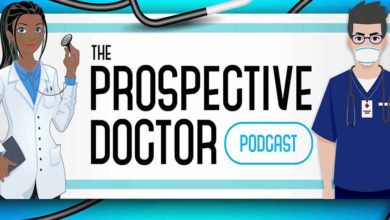Dr. Erkeda DeRouen talks to Dr. Elisha Peterson who is triple board-certified in anesthesiology, pediatric anesthesiology, and pain medicine. She practices at a large freestanding children’s hospital. Today, Dr. Erkeda chats with Dr. Peterson about the field of pain medicine and what it really means to have a “work-life balance”.
[01:27] Pain Medicine and its Treatment Methods[05:55] Is “Work-life Balance” Real?
[10:30] What Dr. Peterson Wishes She Knew Before Becoming a Doctor
[14:51] Different Ways to Practice Medicine
[17:23] Dr. Peterson’s Advice to Pre-meds and Medical Students
What is Pain Medicine?
A common misconception about chronic pain is that it’s an extension of acute pain. Dr. Peterson debunks this by defining chronic pain as a condition that extends beyond the body’s typical healing period. Chronic pain has its own mechanisms that differentiate it from acute pain. Physicians in this field work with patients for prevention, evaluation, and treatment. Methods to treat pain include medication, physical therapy, psychological therapy, surgery, and alternative medicine.
Dr. Peterson presents all the appropriate treatment options and then patients can choose what they prefer. In most cases, psychological and physical therapy are the most effective pain management strategies for kids.
Is “Work-life Balance” Real?
Work-life and personal life are not opposing forces. Instead of constantly trying to choose between the two, a more practical approach would be to identify your priorities. After determining what’s important, you make time for those relationships and activities. Don’t let go of your hobbies and interests. Being passionate about things outside of medicine helps prevent burnout. Physicians have more to their identities than just their day job. Engagement in other fulfilling activities enriches your practice too.
The Truth About the Healthcare System
Prior to becoming one, Dr. Peterson always thought doctors were in full control of their time. This is rarely the case unless physicians have their own private practice. Another thing that came as a shock was the intricacies of the healthcare system. The healthcare system can sometimes be a roadblock for patients. Resources are limited and there are certain policies that make it challenging to provide the right care for patients.
Dr. Peterson’s Advice to Pre-meds and Medical Students
Everyone has their own vision of what being a doctor looks like. Actively seek out the lifestyle that you want to have. Find an individual that models this best and shadow him/her. Go the extra mile and gain experience outside of normal working hours too. Patients continue to come and go whether it’s day or night. It would also be a good idea to expose yourself to backend work like documentation and paperwork. By gaining all kinds of training early on, you learn what your preferences are. Use these experiences to move forward in your medical journey.
For questions about pain medicine, reach out to Dr. Elisha Peterson on Twitter. For more resources about pediatric pain, check out the Rise and Shine blog by Children’s National Hospital and the Surgucation YouTube Channel.
